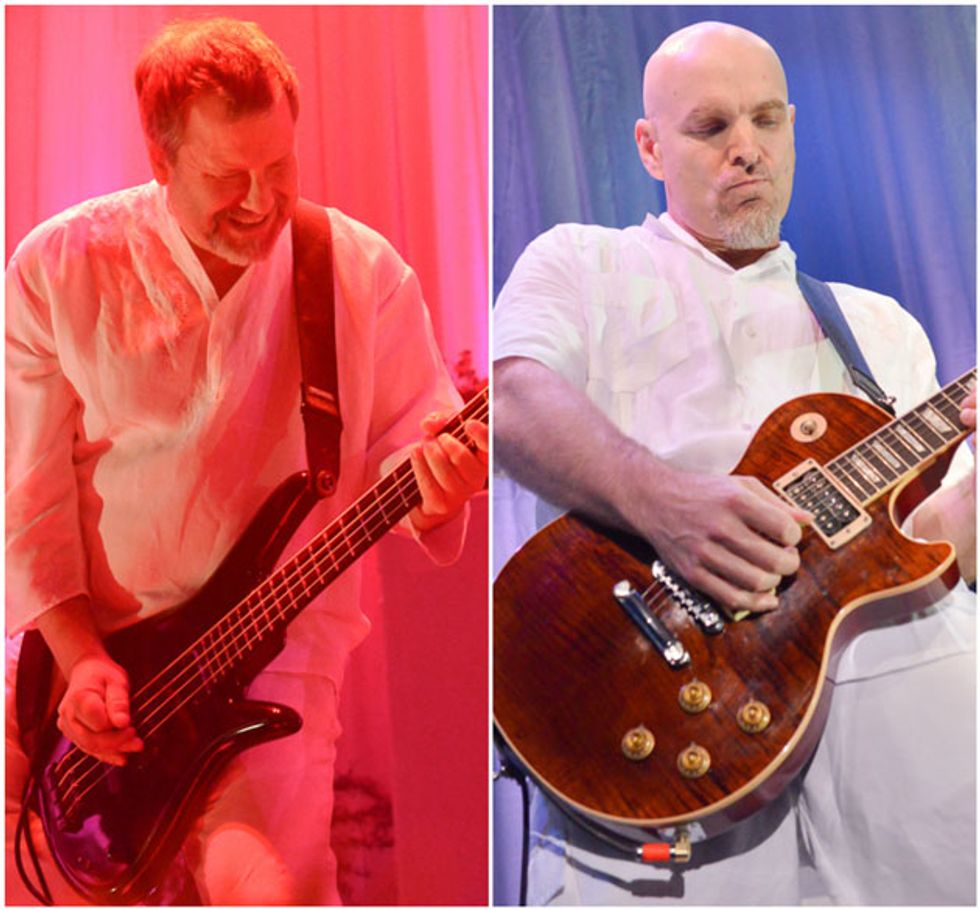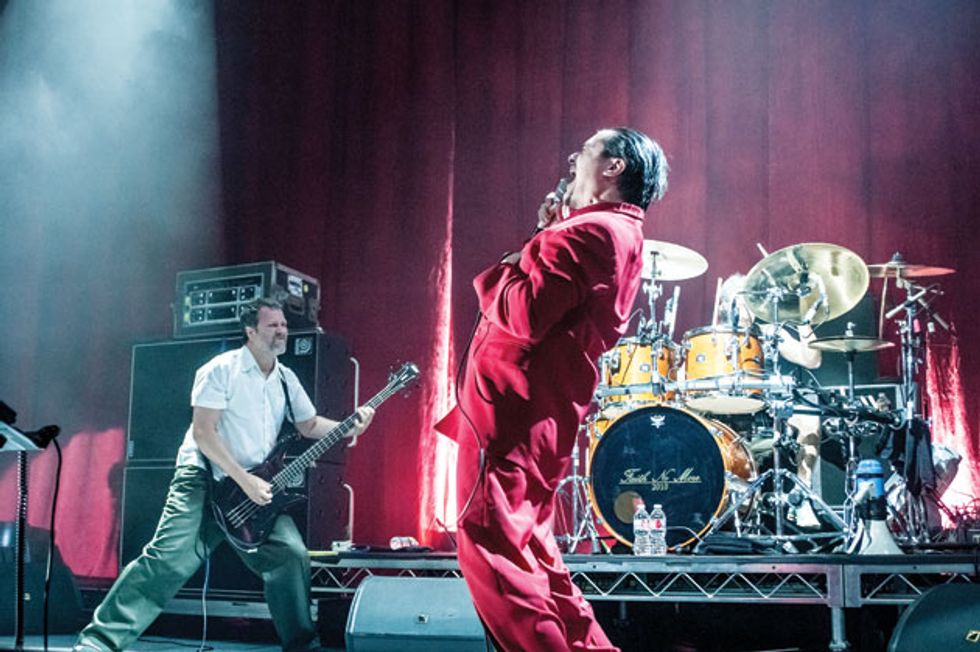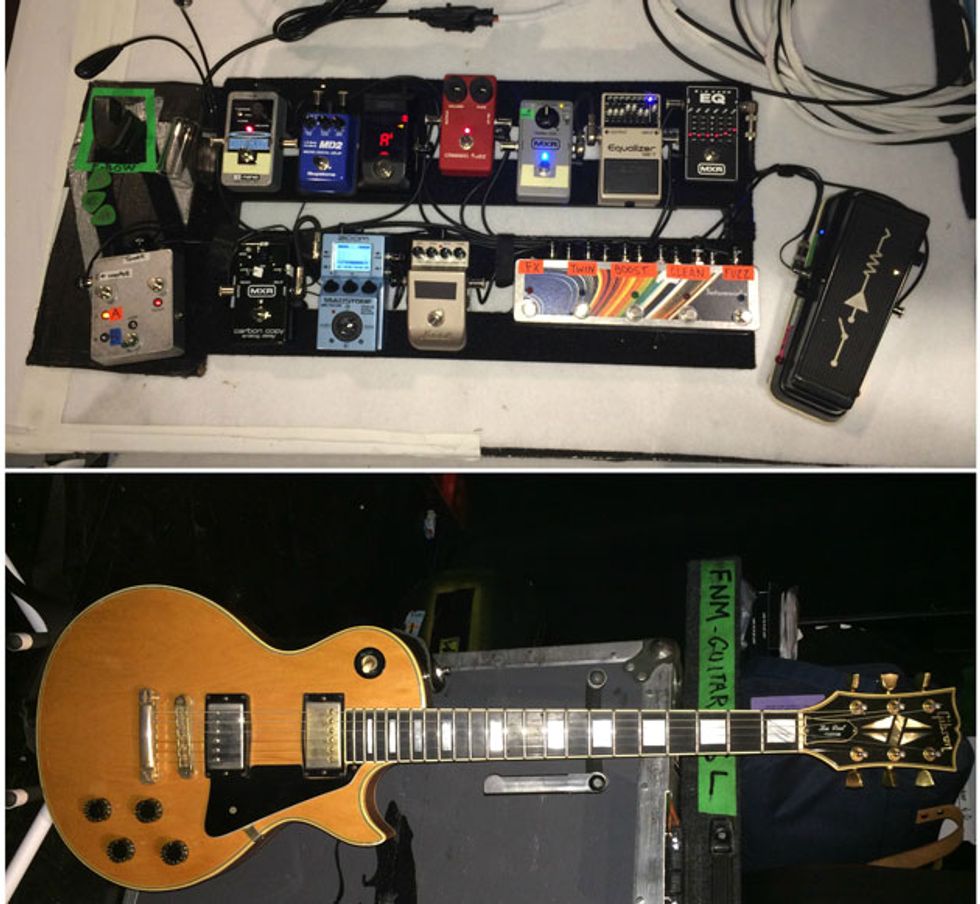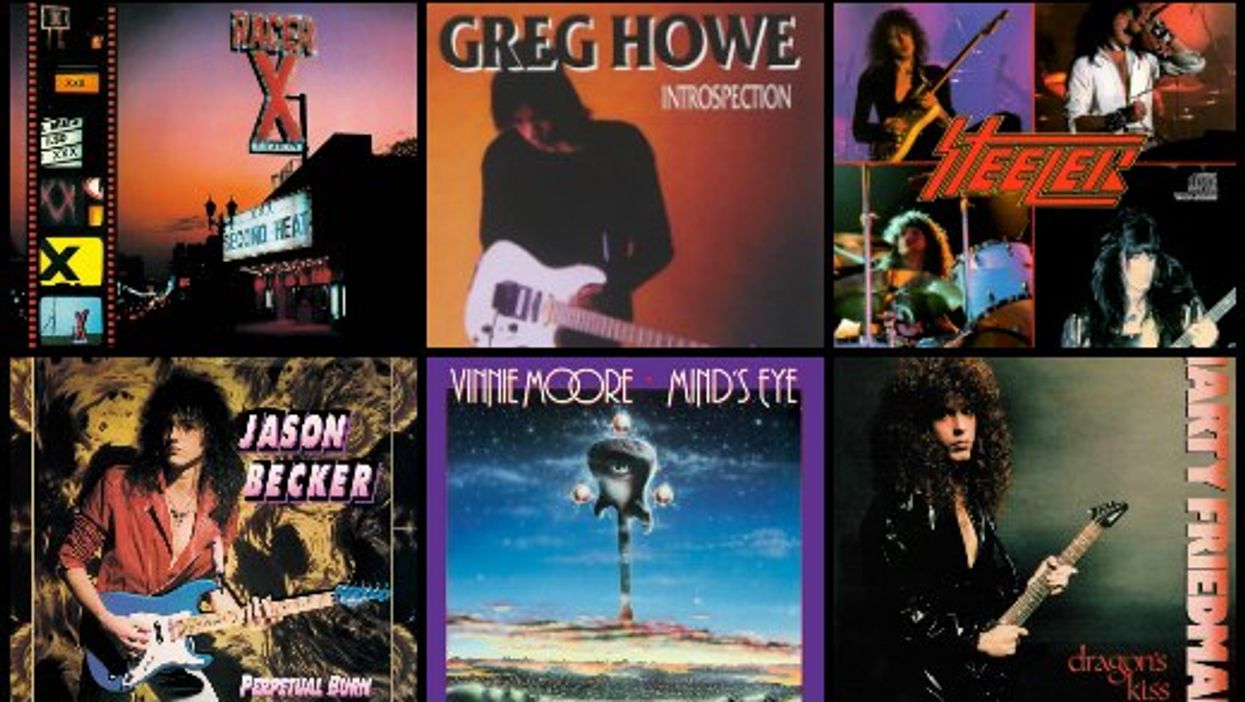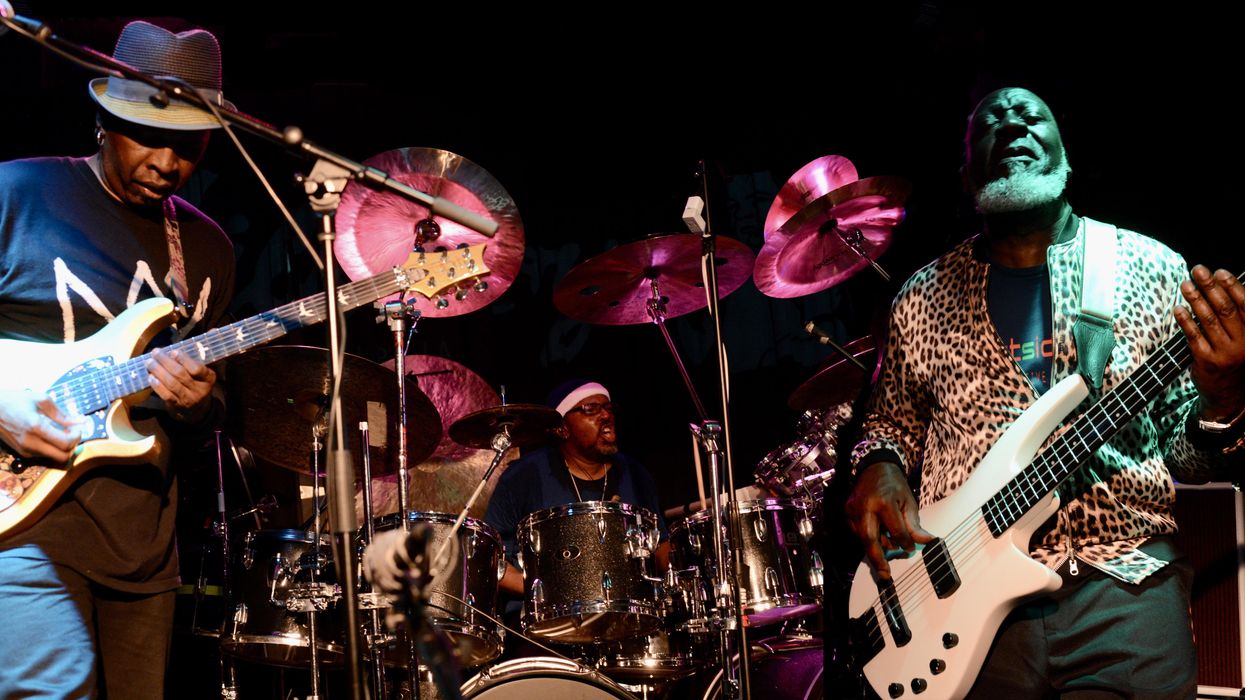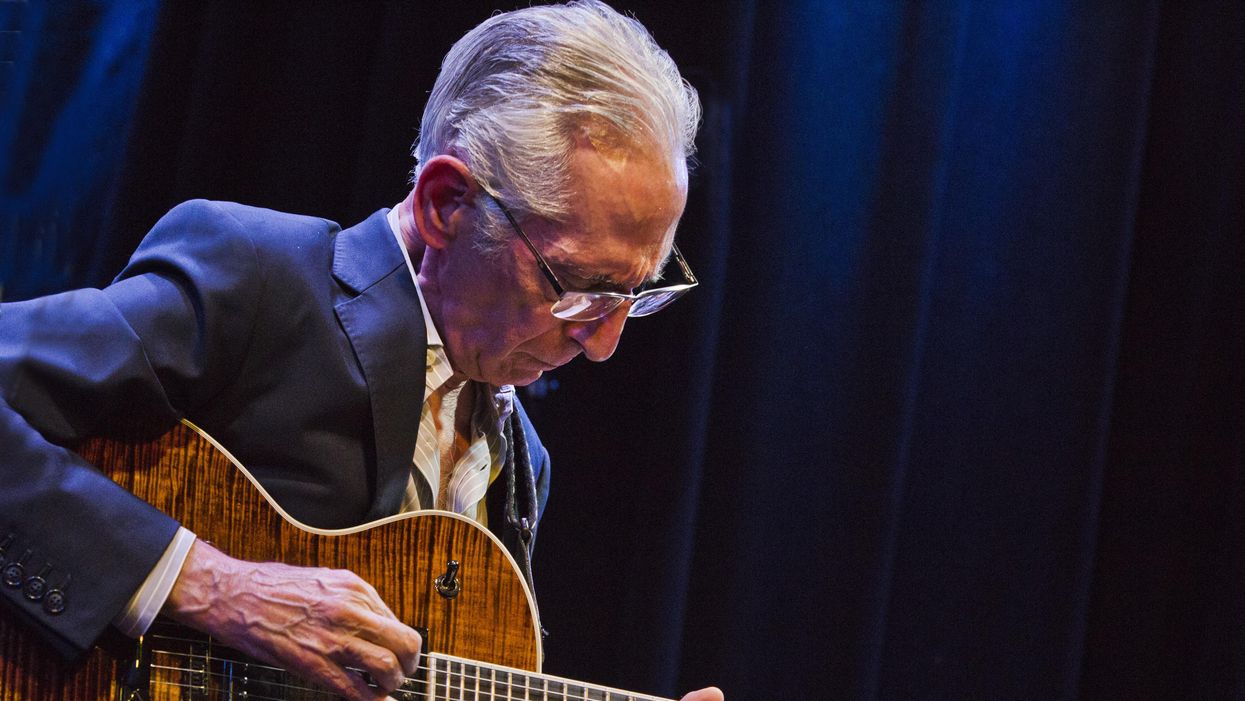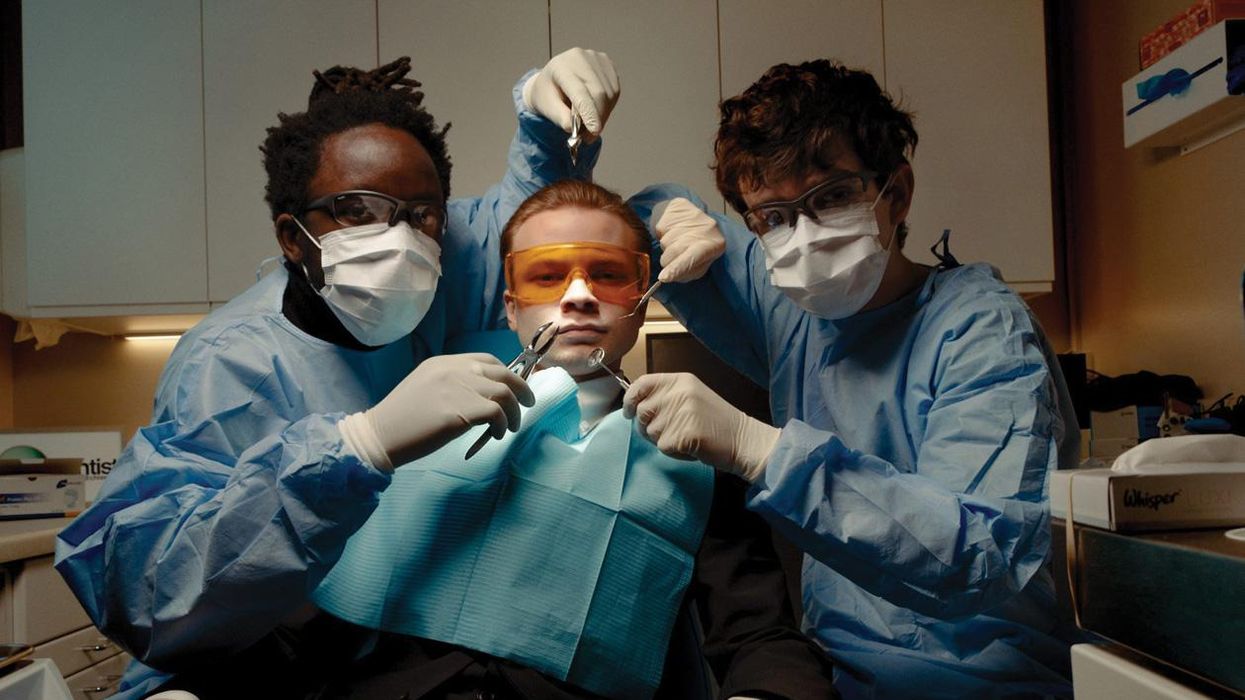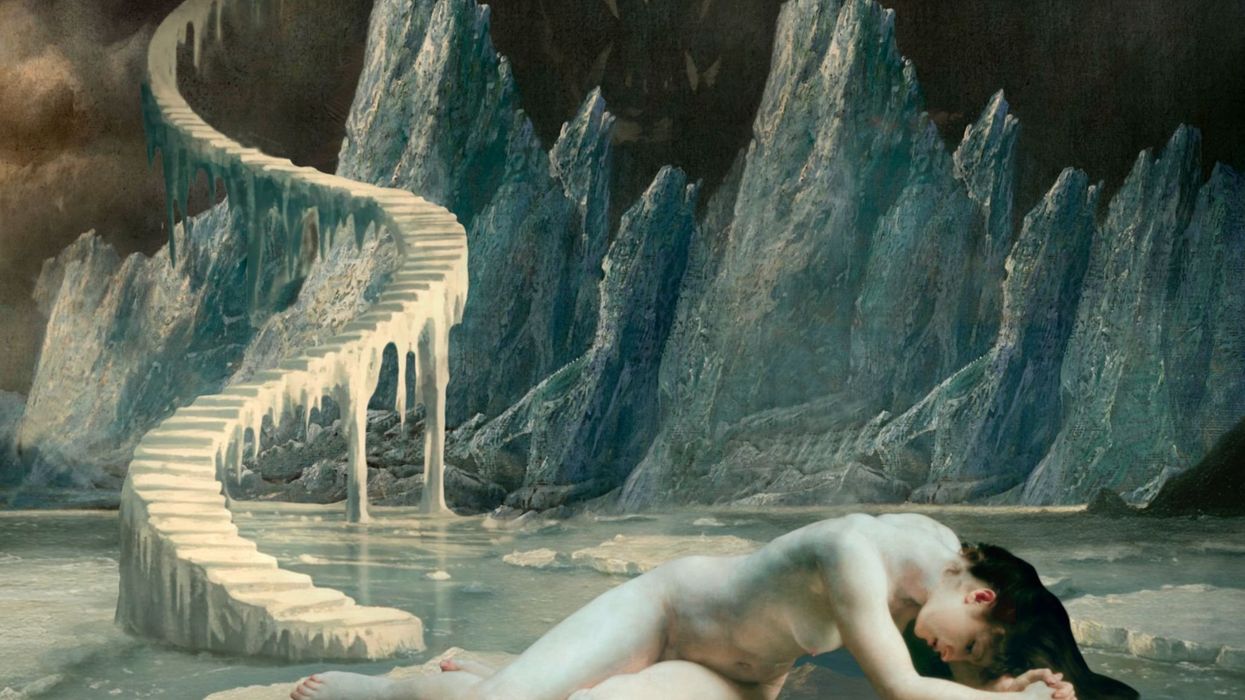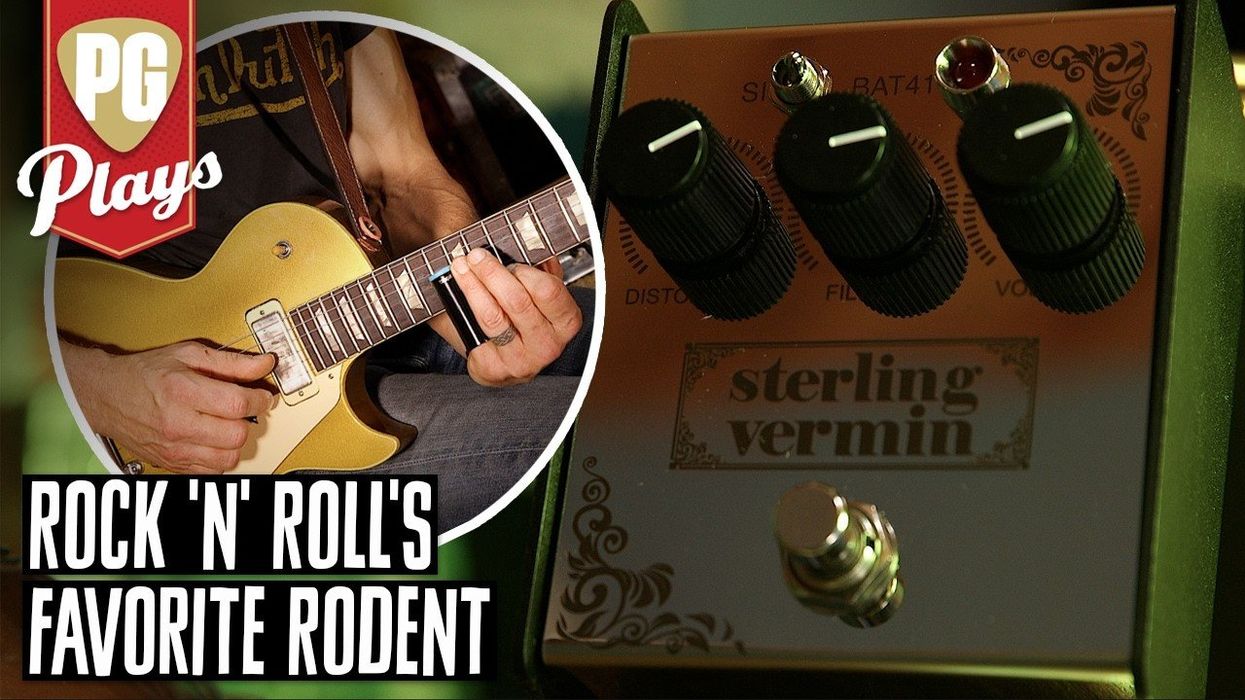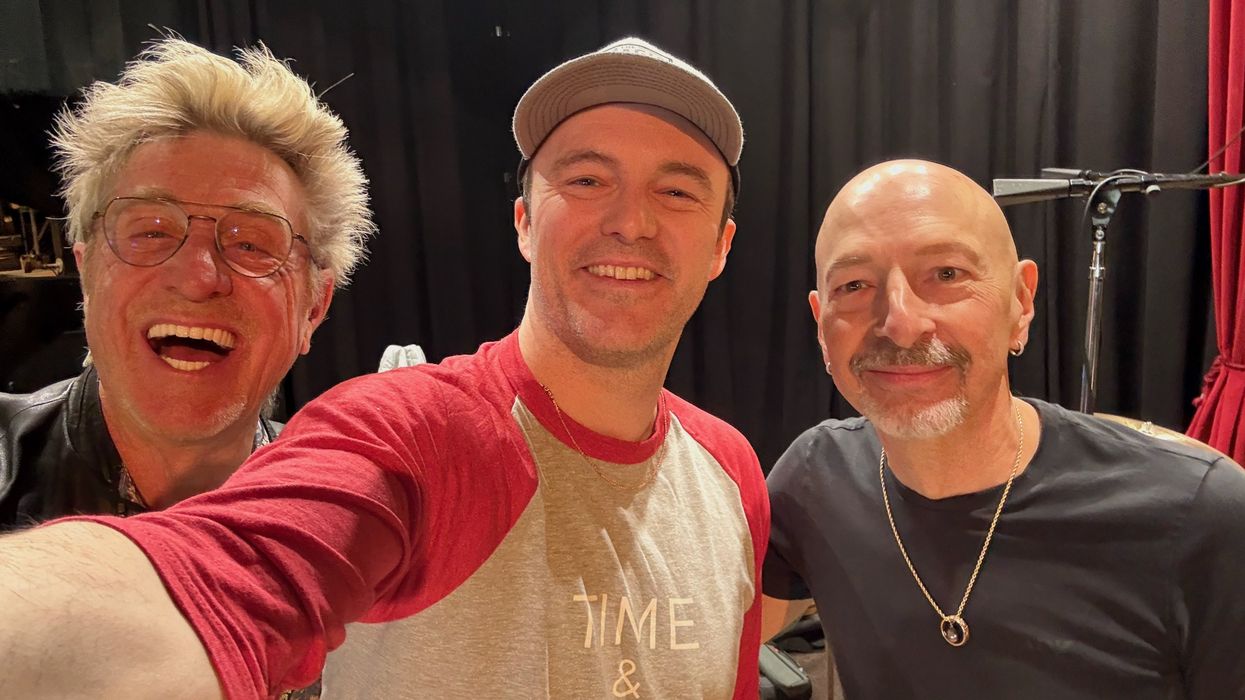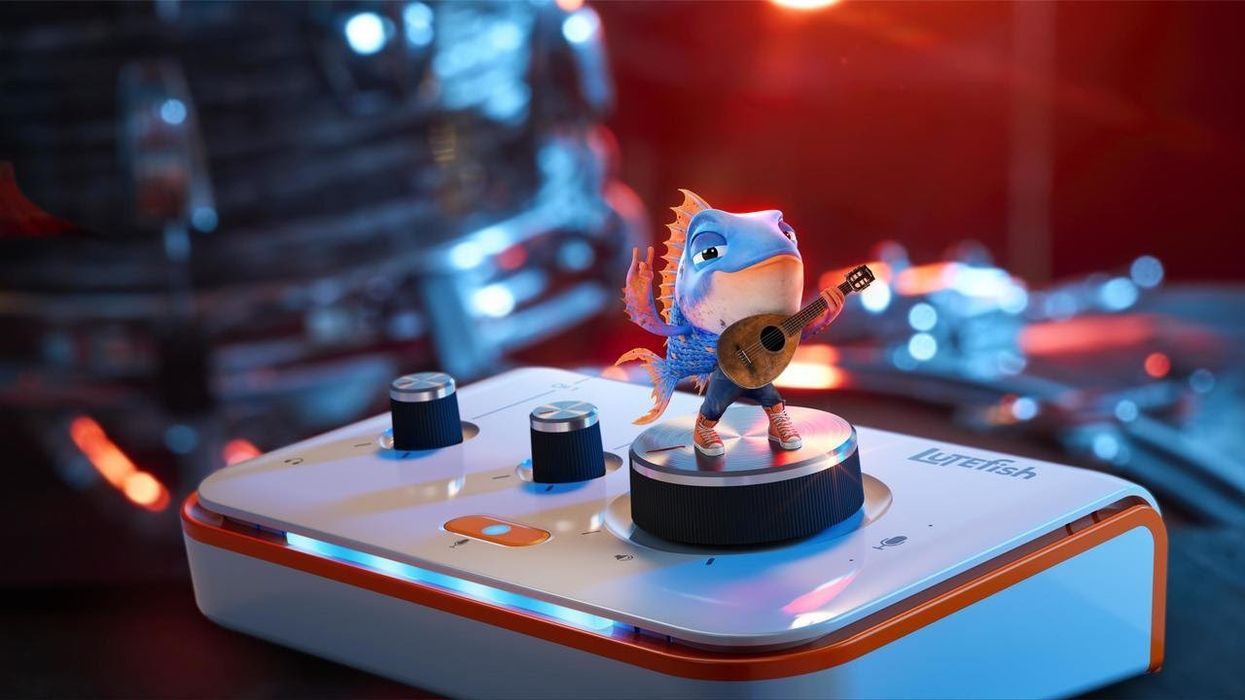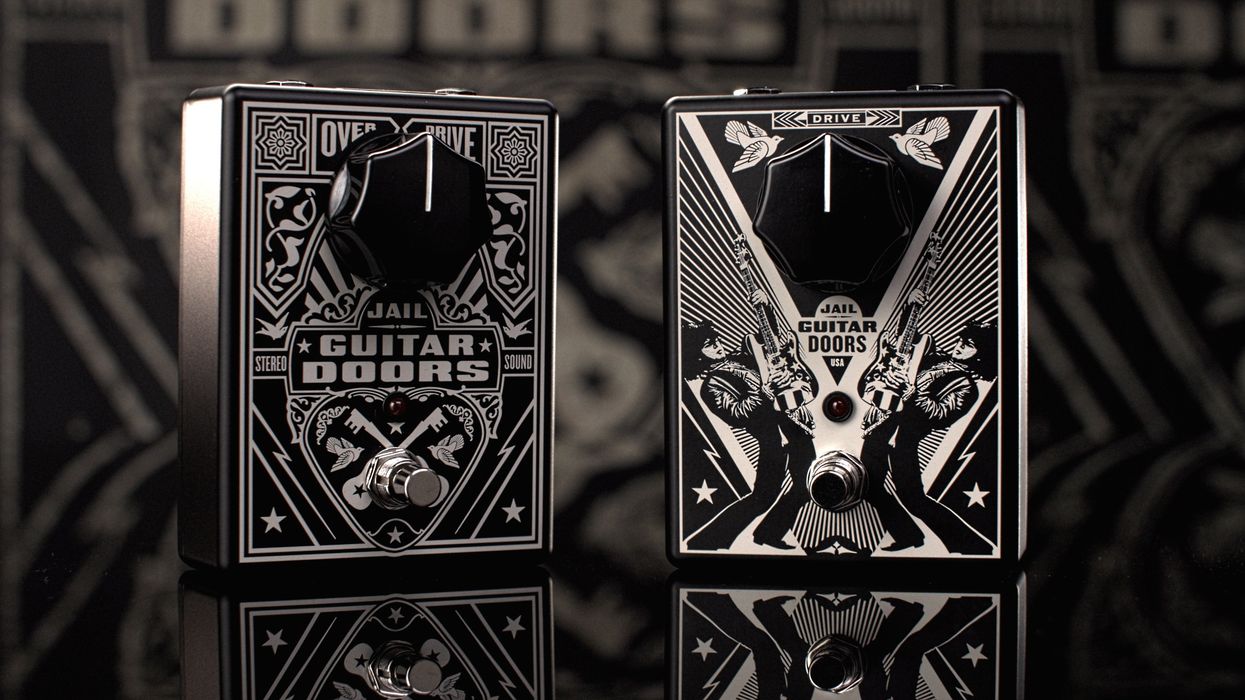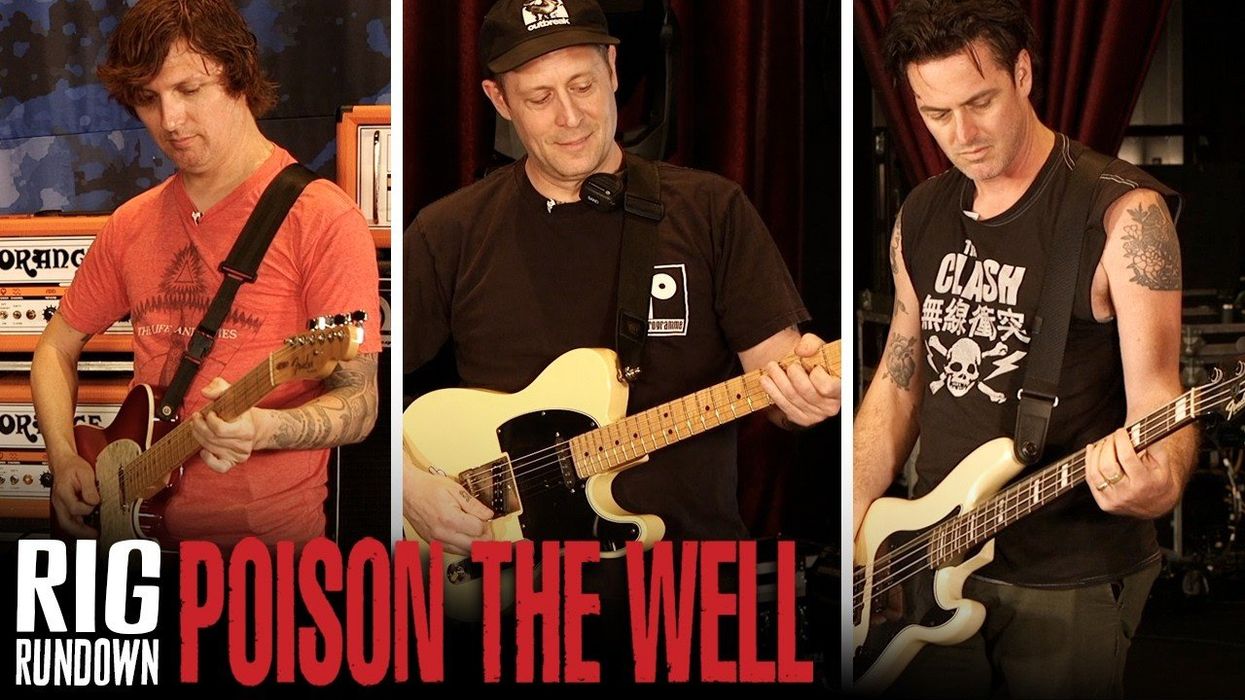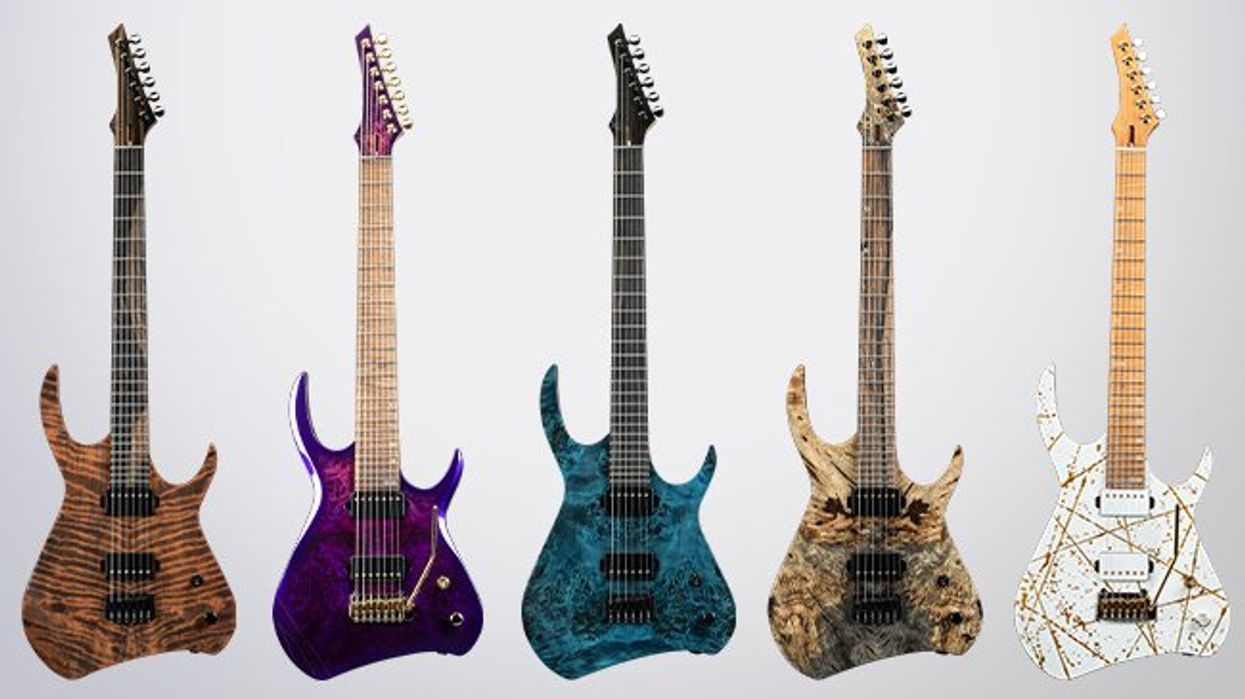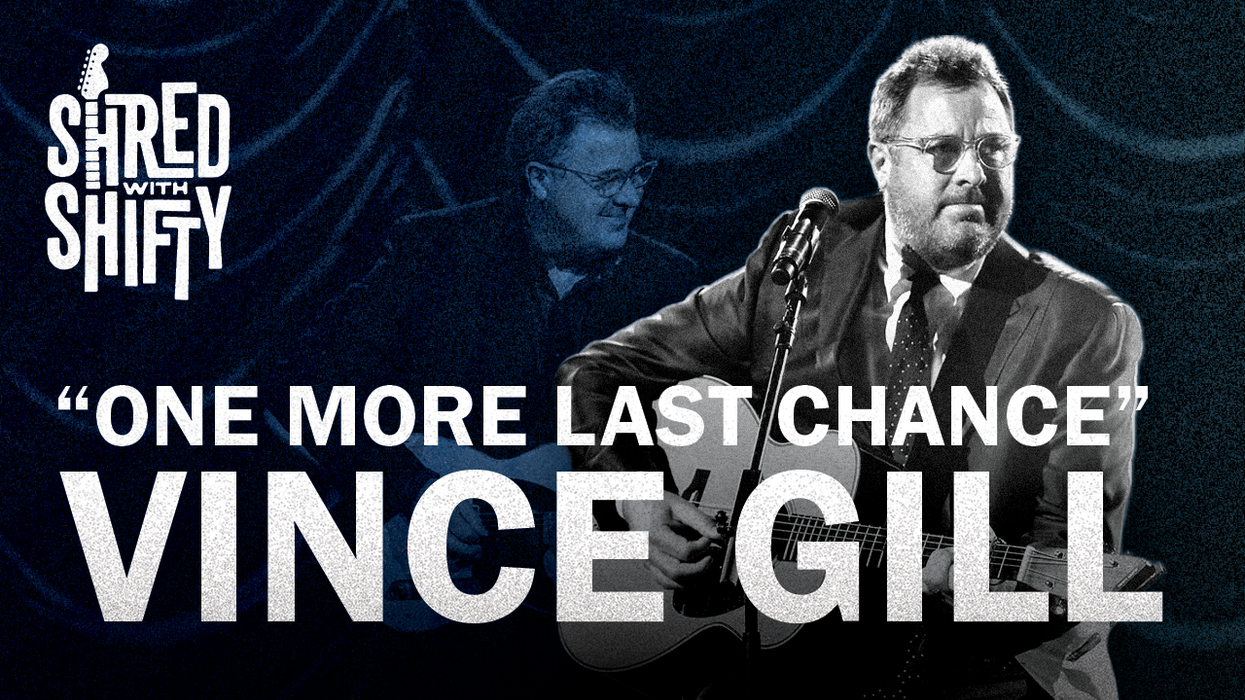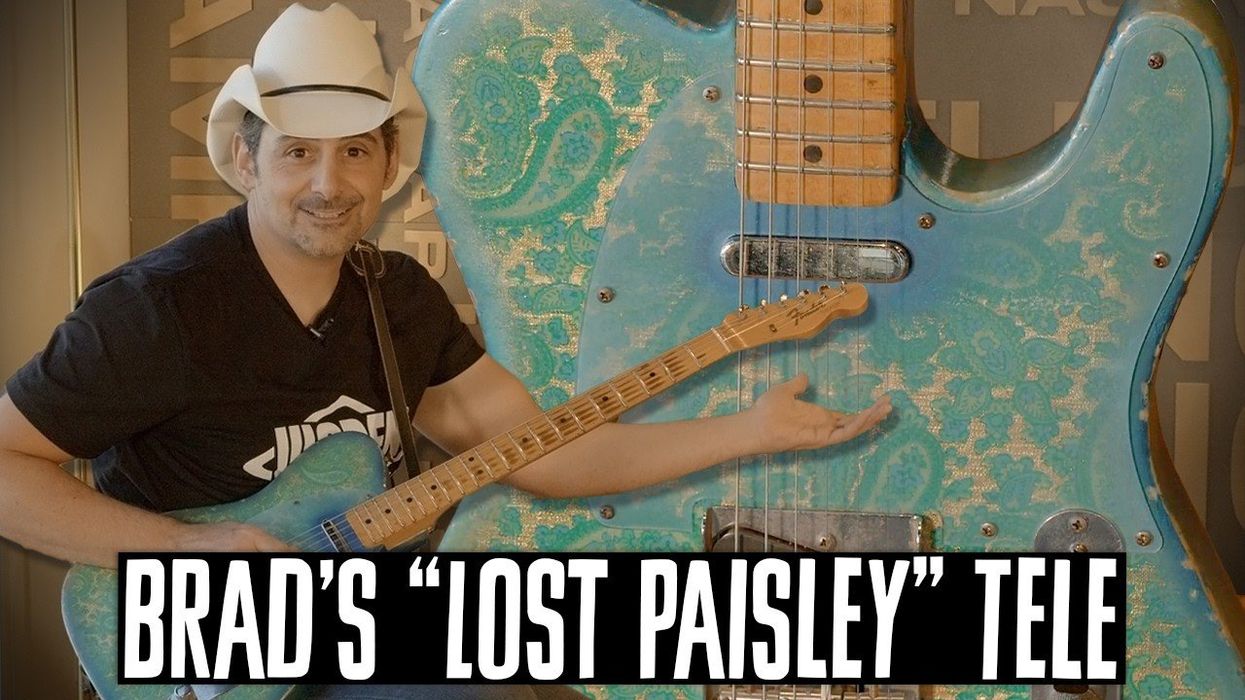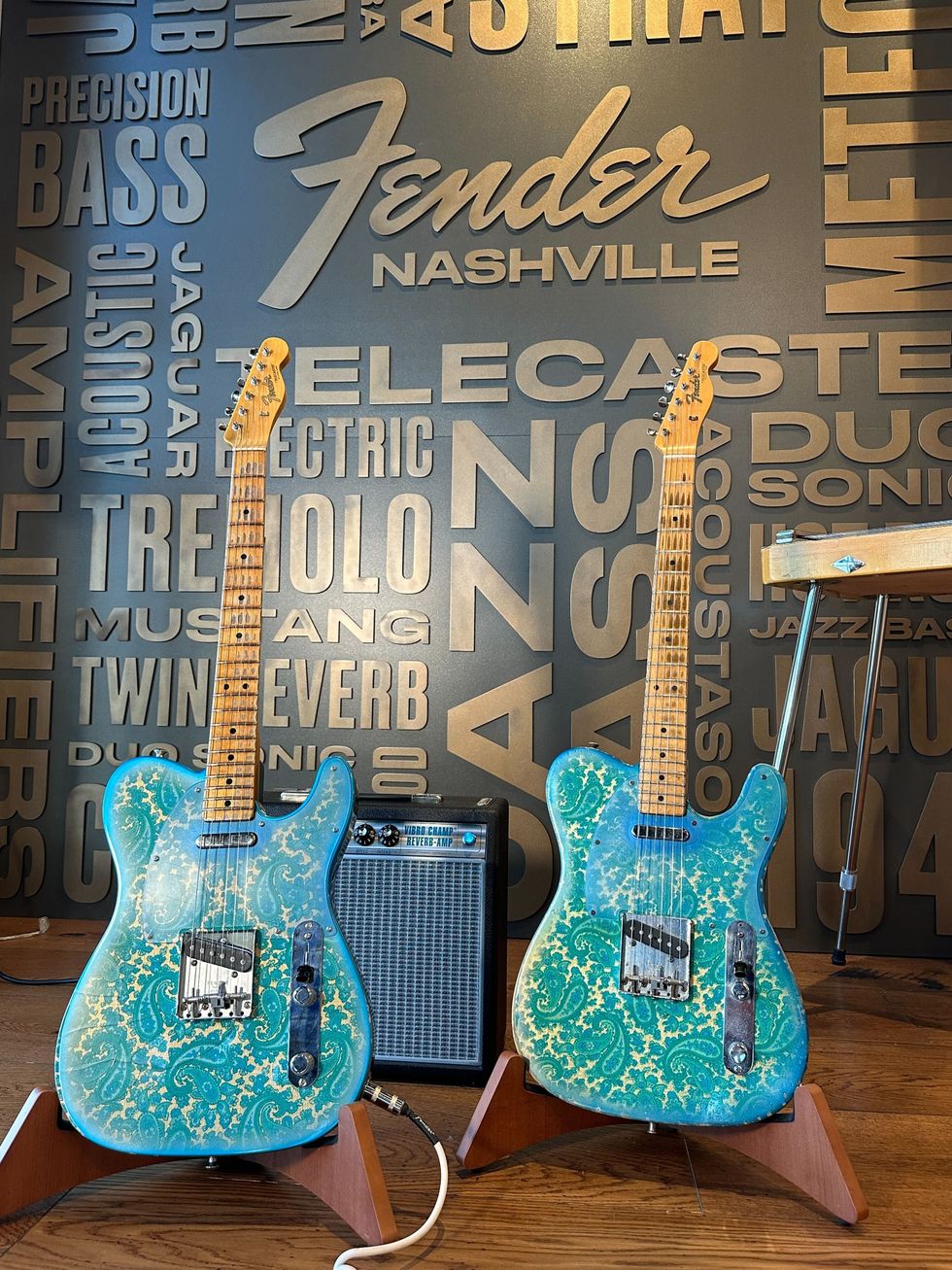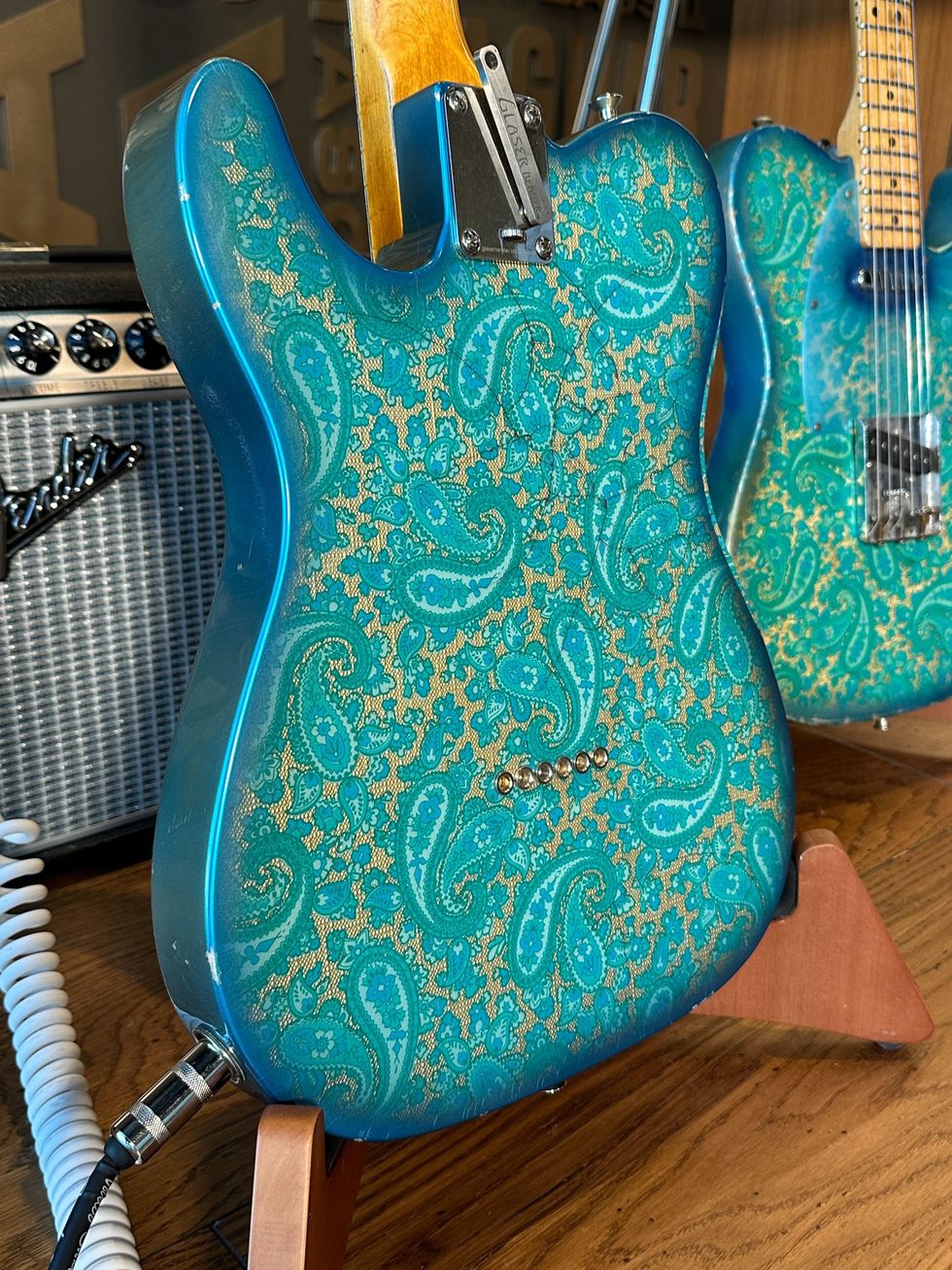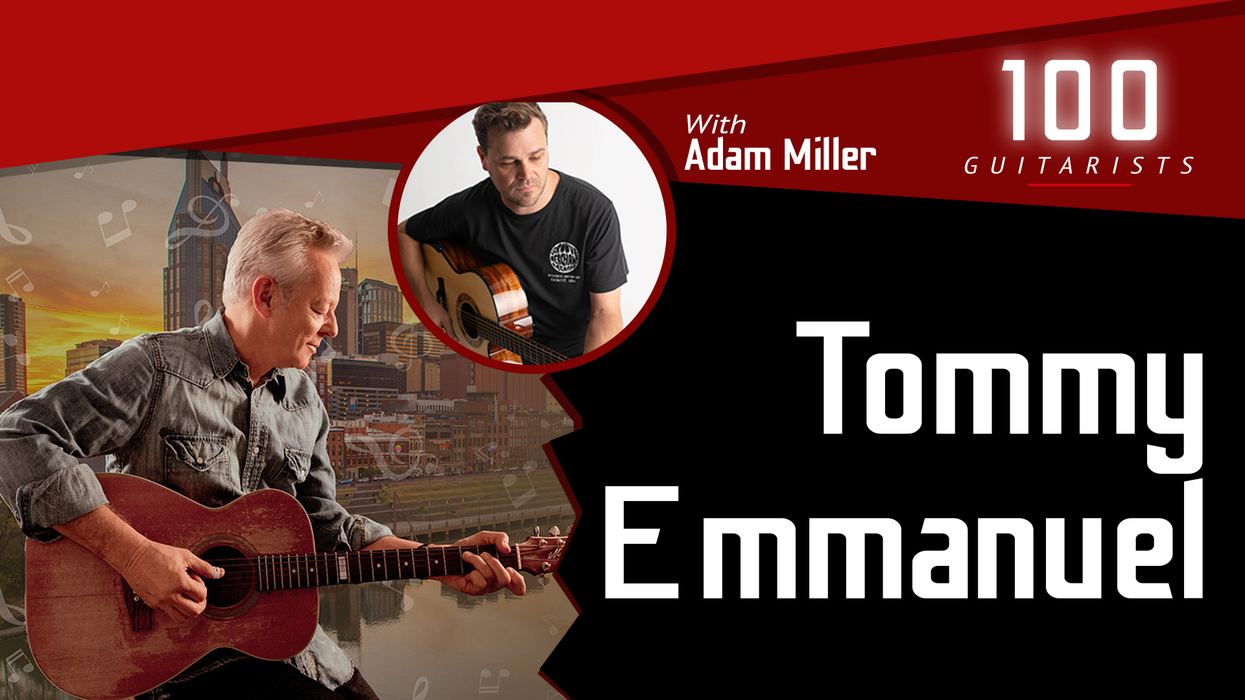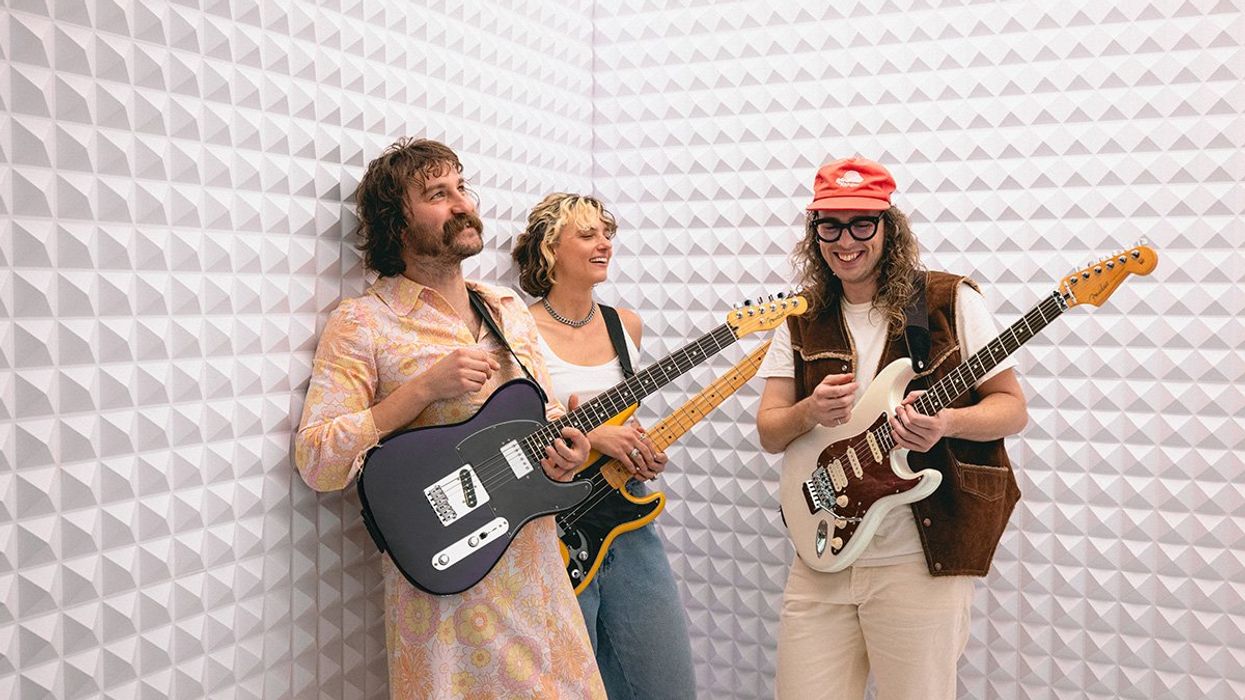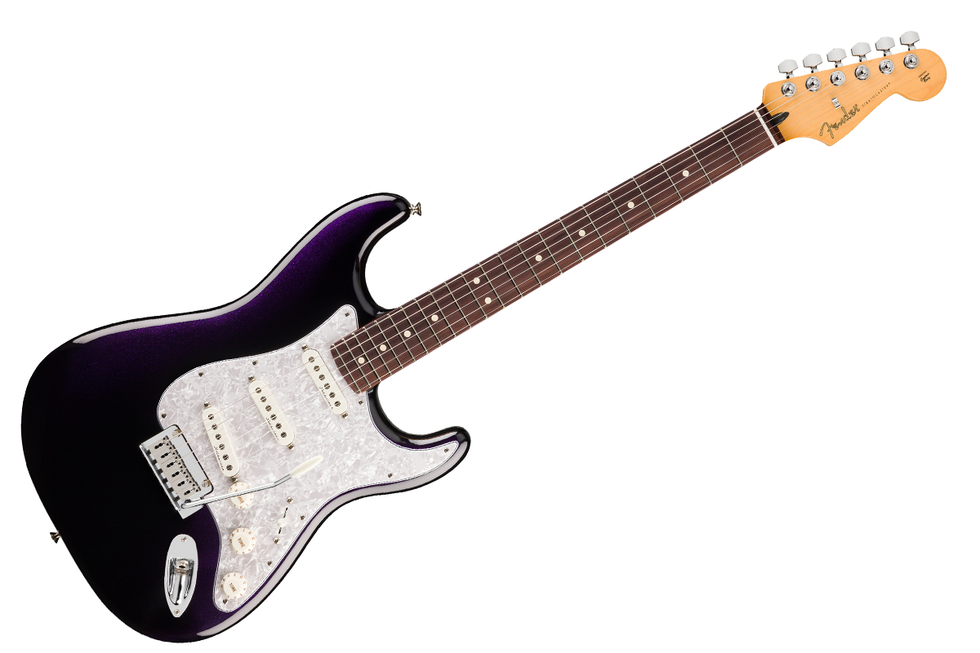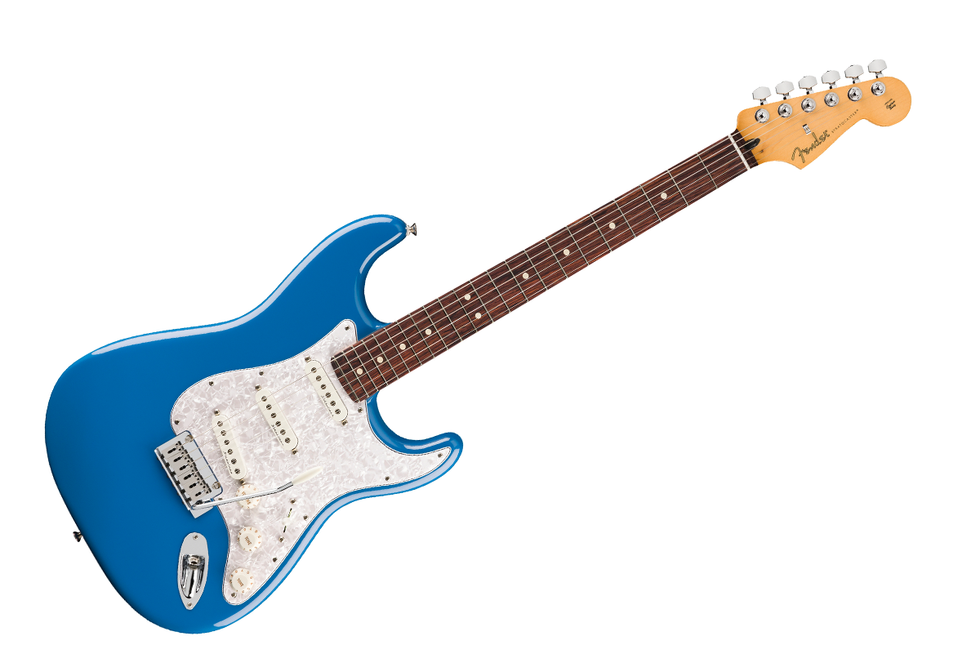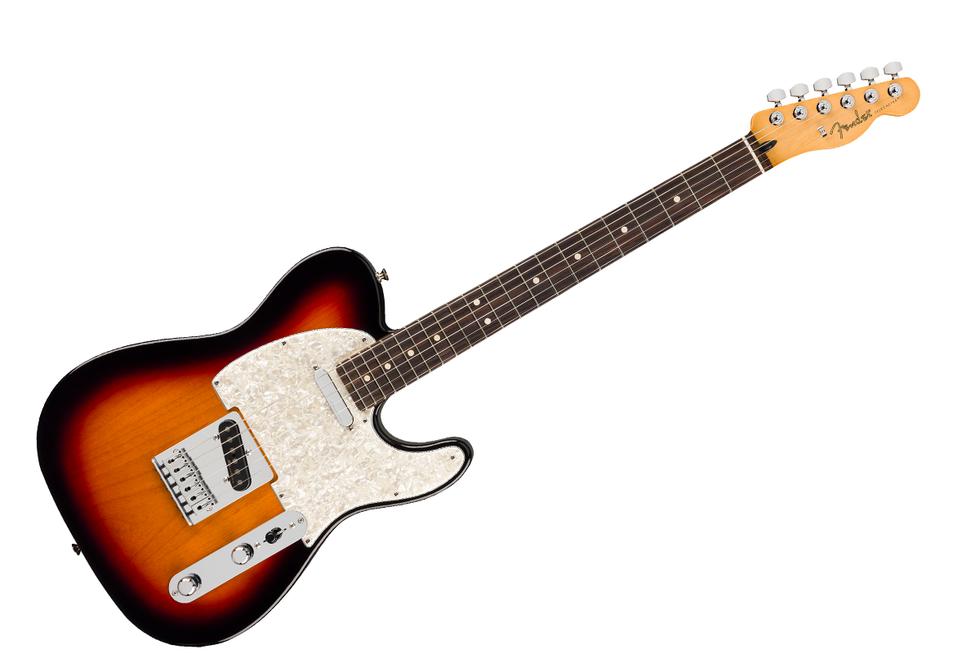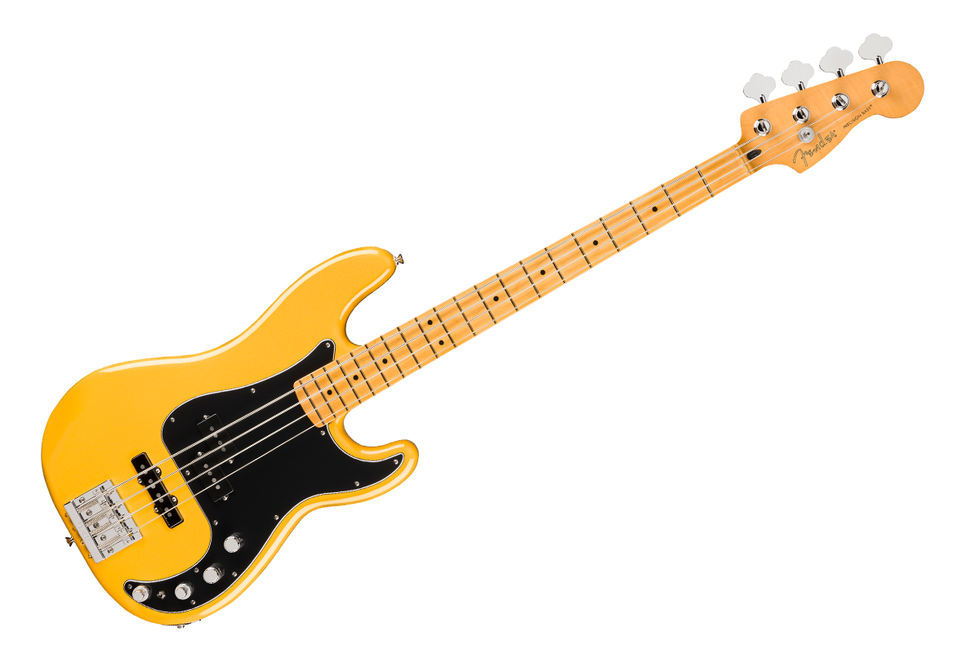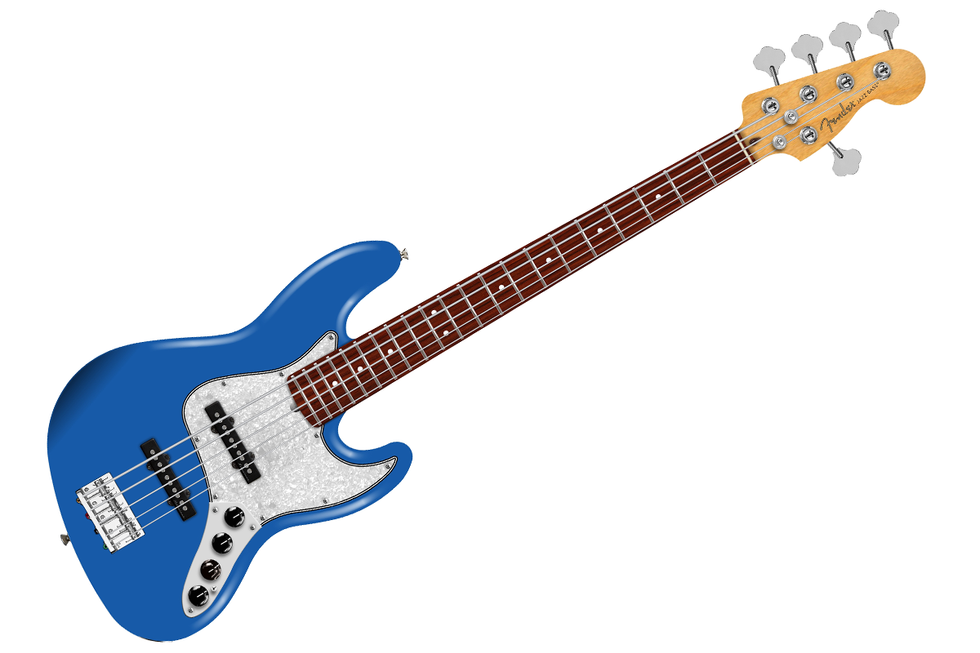Co-founding member Billy Gould (left) hammers out grooving bass lines during the band's recent show in Japan at Shinkiba Studio Coast. The band's newest member—he joined in 1996—Jon Hudson (right) rips off a solo during the band's recent show in Japan at Shinkiba Studio Coast. Photos by Kazumichi Kokei.
In 1998, President Bill Clinton was in office, Michael Jordan and the Chicago Bulls won their sixth NBA title, AOL was the leading internet browser and email service, Armageddon was the No. 1 grossing film, and on April 7, the funk-metal misfits Faith No More played their last gig in Lisbon, Portugal.
Current members bassist Billy Gould, drummer Mike Bordin, and keyboardist Roddy Bottum started the band (originally named Faith No Man) during the early ’80s in San Francisco, where they had a revolving door of singers and guitarists before drafting Chuck Mosley and Jim Martin for those respective chairs. This lineup released Introduce Yourself in 1987. The band eventually fired Mosley and replaced him with crooning, operatic, screaming sensation Mike Patton who solidified the band’s sound and direction by incorporating a more extreme palette of influences, including heavy-and-loud (“War Pigs”), funk-rock (“Epic”), lounge-y, jazz vibes (“Edge of the World”), and least-likely, Middle-Eastern rhythms (“Woodpecker from Mars”). In 1989, they released the platinum-selling, Grammy-nominated The Real Thing, which catapulted them onto MTV’s airwaves and into the mainstream consciousness.
With Patton firmly at the helm, the band pushed forward, blending and distorting musical boundaries on more adventurous albums: 1992’s Angel Dust (guitarist Martin’s last album), 1995’s King For a Day… Fool For a Lifetime, and 1997’s Album of the Year, which was guitarist Jon Hudson’s first recorded appearance. While many of their albums were critically acclaimed, FNM toured relentlessly in an effort to win over audiences.
quite a transition." —Jon Hudson
“We pretty much toured nonstop for a decade because label reps and publicity people would say this area isn’t getting you,” says bassist Gould. “We would record, rehearse, tour, and repeat that cycle every two years or so. By the end of Album of the Year and touring in 1998, we’d had enough of each other and had to go our separate ways. We were toast.”
So they went off and did their own things. Patton put all his energy into Fantômas, Mr. Bungle, Tomahawk, Peeping Tom, Italian operas, video-game voiceovers, and even did time as a singer for Dillinger Escape Plan. Bottum pursued new music as singer/guitarist for Imperial Teen. Bordin went on to drum with Ozzy Osbourne and Alice in Chains’ Jerry Cantrell. Gould worked with Jello Biafra, Brujeria, and produced several albums on his Koolarrow Records label. And guitarist Hudson left music altogether.
Around 2007 or 2008 when Roddy got married, most of the band attended the ceremony and reception, marking the first time they’d been together since the ’90s.
“Since it was a personal thing and we were there to celebrate Roddy’s happiness, we had no pressure or expectations,” says Gould. “It was real casual, but I was apprehensive about it since we hadn’t been in the same room together in nearly a decade, but everything was great. My thing was if the vibe was weird, tense, felt forced, or we didn’t get along, it would be a telltale sign that any type of a reunion wasn’t in the cards. Thankfully, everything went great and that was the first step to where we are today.”
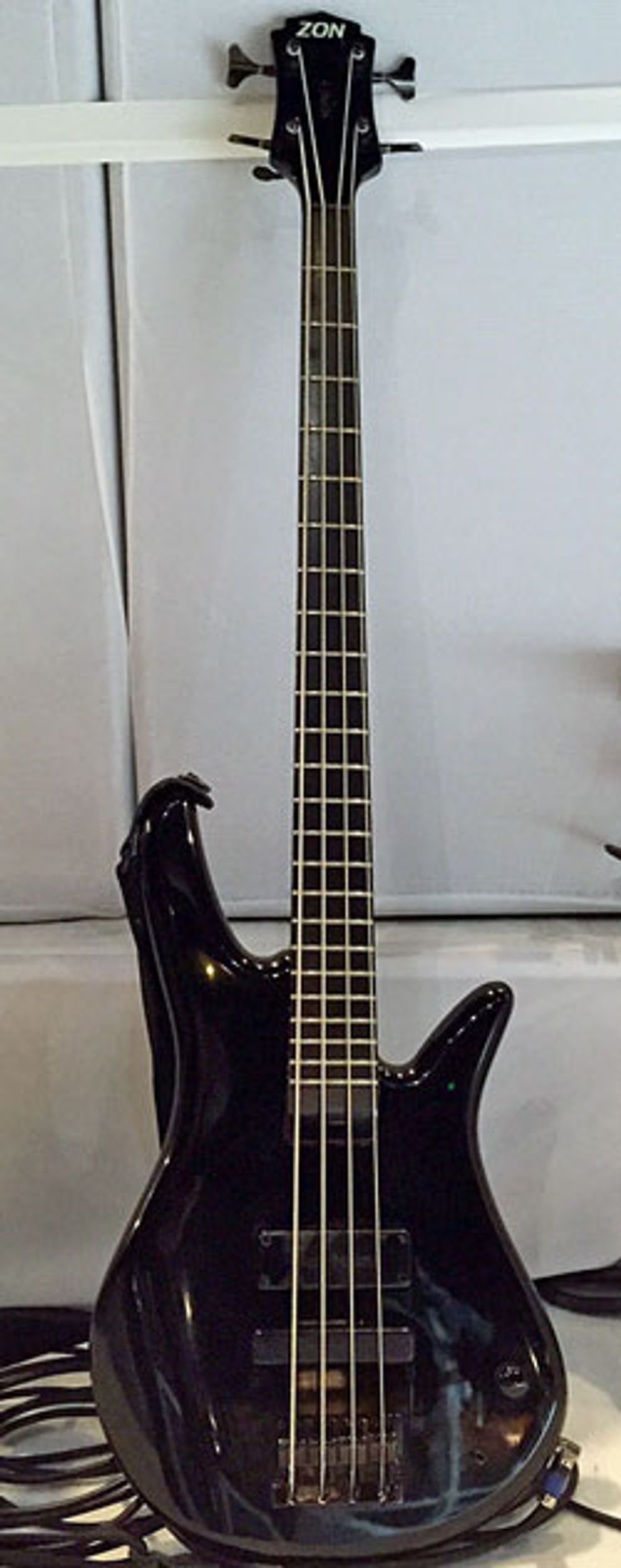
Billy Gould's signature Zon Sonus bass has an onboard preamp designed with Greenhouse Effects Roy Zichri so Gould doesn't need any effects onstage. The bass also has proprietary-designed Bartolini pickups first put in his basses in the early '90s.
After years of reunion shows and festival appearances, the band quietly decided to start recording new material. Released nearly two decades after Album of the Year, FNM’s new album Sol Invictus proves they can still harness the manic energy of their earlier music. We recently caught up with Gould and Hudson, and they described the reformation process, what it’s like to self-produce a record, and why neither of them use distortion or overdrive pedals.
Jon, you essentially quit professional music. What was your day job?
Jon Hudson: I worked in property management—I oversaw condominiums for Homeowners Associations in the Bay area. Getting paid to play music is crazy, and to have that be your day job is just incredible. To go from that into management is quite a transition.
When the band split up, I toyed around with having my own band and putting out my own record, but I couldn’t really find the right people to work with at the time. I was also trying to be realistic about it. I just thought, look, I had a great run with the band, but it didn’t pan out, so I switched gears and grew up. Managing a portfolio of properties was probably the most challenging thing I’ve ever done. I’m glad to be playing music again for my day job [laughs].
Do you remember when you decided to move beyond playing reunion shows and actually make a new album?
Billy Gould: A lot sooner than we announced it. The problem is when you haven’t put out music in 18 years and you start hinting that you’re going to do something, the hype machine starts up. We just wanted to be absolutely sure that we had enough material we were really happy about—that means all of us, not just one of us—before actually taking the necessary steps to being a living, breathing band again.
Hudson: For about five or six years, we just enjoyed playing the old material. It was nice to be around the guys again. I don’t remember who brought it up, but at some point we decided to try writing new material. It was so informal that it practically went by unnoticed. It was very relaxed and we had no pressure on delivering anything other than to ourselves.
Bassist Billy Gould digging into his signature Zon Sonus BG4 bass during the band's initial reunion shows alongside longtime singer and collaborator Mike Patton. Photo by Lindsey Best.
Were the Sol Invictus sessions similar to how you worked on Album of the Year?
Gould: I’d say pretty similar. We have a certain way we work and collaborate with all of our personalities. What did change is that all of us have become technically better at what we do, so we can actually work better independently than we used to. Also, because we’re all better at our craft, it allows us to openly tell each other what we’re thinking. It’s not about being right or better, our goal has always been to just put out the best album as a collective unit. With everything up to and including Album of the Year, we were always working in the studio with a producer and an engineer—I learned so much from Andy [Wallace], Matt [Wallace], Roli [Mosimann] and others, but I think we’re now to the point where we can work amongst ourselves and avoid any outside coloring.
Hudson: This time felt much more relaxed. We’re putting the new album out on Mike’s [Patton, singer] label Ipecac Recordings, so we had unlimited time and no expectations.
During the Sol Invictus sessions I always had a DI track of guitars running, so we had additional options during mixing. I never did anything like that on Album of the Year. We actually took the DI track and ran it through a Kemper Profiler. We’d listen to how those rhythm tracks sat in the mix, and then use the Kemper to reamp the DI track and fill up the sound.
Early on Billy and I decided that I’d basically use my live setup for recording—my old Marshall head and cabinet with a Les Paul Standard. We set up a few different tones on the amp’s various channels and then ran a few mics on the cabinet. We really dialed in the sounds beforehand, as opposed to over-EQing those tracks later on, which can sometimes cause phasing issues.
Billy, you’ve produced other bands and have co-produced some of Faith No More’s earlier work, but on this album, you’re the sole producer. Describe that experience.
Gould: It’s definitely been a challenge. I felt like the bar was set pretty high by the other guys we worked with, so that made me step up a little bit. It was fantastic because the band gave me a lot of confidence and support through the whole process. At the end of the day, we’ve all been making records for so long that it’s now just a group thing—I’m driving the car, but we’re all on the same journey together. I’m kind of just the engineer or the manager of the technical side.
Do you think the band’s broad musical palette made it easier to make a Sol Invictus after a long hiatus, since you couldn’t be pigeonholed into a specific category other than Faith No More?
Gould: I’m glad you hear that! That’s what we were hoping to accomplish—it was definitely one of our greatest concerns. It’s kind of common that at some point, bands we loved growing up mature, write some good stuff, but their sound and dynamic changes. Sadly, more often than not, they kind of suck—I think that’s more often the rule than the exception. We never wanted to be one of those bands. I don’t think it’s happened yet and I’m very happy to say that.
Hudson: Mostly I think it came naturally. I don’t think that it was like pulling teeth or anything, and it wasn’t a particularly arduous process. We just kept working and before you knew it, we’d made an album and it’s 100 percent Faith No More.
Jon Hudson's Gear
GuitarsTwo 2004 Gibson Les Paul Standards
1981 Gibson Les Paul Custom
Early ’90s Gibson Les Paul Traditional
Amps
1980s Marshall JCM800
Effects
MXR M135 Smart Gate
Boss GE-7 Equalizer
MXR M109 6-Band Graphic EQ
Guyatone MD-2 Digital Delay
MXR Carbon Copy Delay
Electro-Harmonix Holy Grail Nano Reverb
Zoom MS-50G Multistomp
Marshall RG-1 Regenerator
Custom Audio Electronics MC404 Wah
Strings and Picks
Dunlop 1.0 mm Ultex
Dunlop Nickel Wound (.010–.046)
Billy Gould's Gear
Basses and GuitarsSignature Zon Sonus BG4 with onboard Greenhouse-designed preamp
Fender Classic Player Jazzmaster
Amps and Cabs
Fender Bassman 300
Aguilar Tone Hammer 500
Kemper Profiler
1990s Peavey 8x10 cabs
Effects
None
Strings and Picks
Dunlop .88 mm Tortex Triangle
Dunlop Nickel Wound Bass Strings (.045–.105)
Jon, in the opening title track it sounds like you’re really trying to make the delays or reverberated parts musical.
Hudson: You’re right, the guitar parts in that song are delayed pretty heavily throughout. I don’t really play many notes, but the objective was to make eerie, ghostly notes through the reverb and delay trails.
Do you recall what you used for delay?
Hudson:We used plug-ins. I honestly don’t remember which one because Billy handled a lot of that business behind central command [laughs]. I know in live settings I’ll be using a Zoom Multistomp that has three or four delay presets on it—each setting is just a little bit longer of a delay time. Delay has never been an integral part of my sound. It’s just a little added effect.
In the last song, “From the Dead,” are you playing a lap steel or a slide guitar?
Hudson: Billy actually played slide guitar for that song after everyone else thought it was done. I was pretty floored when I heard it and felt it added to the song so much.
Gould: I just felt that outro part needed a little bit more emotion. I heard it in my head, so I tried it and it worked out. The guys responded really well to that addition. It’s really just colors and textures I’m adding—I’m a shitty guitarist [laughs].
Do you recall what guitar you used or amp you used?
Gould: I believe I used a Jazzmaster into the Kemper.
Are there any other guitar parts that Billy played?
Hudson: Bill plays the solo on “Superhero.” It’s really great. The arrangement had changed, and Bill recorded that at the last minute after I tried tracking it, but what I played didn’t add anything and his take has a great vibe and meshes really well with the song. Sometimes you have to concede and be happy he’s in your band and your producer [laughs].
Gould: I wrote that song, so I threw that part together as a placeholder to show Jon what I was going after. When he came in he had a few runs at it, but ultimately he told me to just use my original recording. I was like, “Are you sure, Jon?” He was totally supportive—that’s just an example of how everyone has matured and we can work for the greater song rather than worrying about who played every note on the record.
Jon, are you playing at the end of “Separation Anxiety” where the solo carries out the song?
Hudson: Yeah, I played that. The song continues to slowly build to that point and the solo kind of becomes the catalyst for everything else happening in the track. I really wanted to nail that frenzied little part to continue pushing the song right up to the end.
Here is guitarist Jon Hudson's go-to live setup—a respectable pedalboard with two EQ pedals (a Boss GE-7 Equalizer and MXR M109 6-Band Graphic EQ) that he uses to lower and boost the amp's volume and his 1981 Gibson Les Paul Custom.
Billy, talk about the groovy, slithering main bass riff in “Sunny Side Up.”
Gould: That was the last instrumental part we added in that song, which usually isn’t the case, so it was definitely a challenge to work from that angle or perspective. Since the structure of the song was already there, I tried to play around the drummer. Usually I’m pushing the drummer along, and normally I have a thing where I kind of play bass like a drummer, so we’re always playing off of or against each other. This time I just decided to kind of sail around it and play a little more syncopated. For a Faith No More song, it’s not our typical approach. “Sunny Side Up” might be my favorite song on the record right now.
And about two minutes into “Matador”—when Mike’s vocals shift from singing to an almost spoken word—that bass line steers the song. What was your goal for that part?
Gould: Just like anything I play in Faith No More or any project, I try to put a groove into the song. What’s catching your ear is probably weird 7/8 timing that we’re playing through most of the song. It’s not in your face, but you notice something is just off, but in a good way.
Let’s talk gear. Jon, are you still using the Marshall-Fender dual-amp setup?
Hudson: No, I got rid of the Twin. I love Fender Twins, but it becomes problematic to get a good balance between amplifiers onstage. The levels got off, and sometimes it became more of a hassle than it was worth. A few years ago, I started trying to get everything out of my JCM800. Right now I just have a Boss GE-7 Equalizer that boosts the midrange a little bit—that’s sort of my overdrive/boost. I can obviously boost that signal and get it to go a little more over the top, but my other EQ pedal—the MXR M09—pulls almost all the frequencies down by 10 dB. I’ll leave a couple of the upper frequencies intact, but I’ve also tried pulling the full signal down, too. The amp is consistent the whole time, so the tone isn’t altered.
I’ve had different overdrive pedals, but sometimes when I go back and listen to recordings, I feel they compressed the sound more than I wanted. The tonal character changes and the guitar disappears. That’s an issue I sometimes have with a lot of high-gain amplifiers as well.
Billy, your signature Zon bass has an onboard preamp for instant distortion. Did you use that at all while recording or is that just a live thing?
Gould: No I didn’t record with it—it’s on my bass to kind of replace the Fulltone Bass-Drive in my live rig. Roy [Zichri] at Greenhouse Effects and I worked on this idea for a preamp circuit that’s kind of like a parallel drive. Not a distortion—it just adds a little bit of drive and a little bit of edge.
If you disengage it, it goes back to passive I imagine?
Gould: Exactly. It takes the circuit out completely. The other thing that’s cool about it is that when I tour a lot, sometimes I can’t bring my amp with me and the backline gear is a struggle to work with. With something like this onboard preamp, I can actually bypass a lot of those problems by having the tone come from the bass.
Tell us about your signature bass.
Gould: The signature models that are coming out are actually based on the first Zon I got back in 1990. Joseph made me something to the specs that I needed, because I have small hands, and I needed to feel comfortable touring and playing every night. My old No. 1 bass broke a string, so I used the Zon for the rest of the show. That was it—I haven’t used too many other basses since then. The Bartolini pickups in the signature models are based on the original pickups I got back in the early ’90s. This bass coming out now is my bass of 20-some years ago.
That Fender Bassman 300 you recorded with is a big tube monster. Will you tour with that or pare things down?
Gould: What I’m using now is an Aguilar Tone Hammer 500. I really like it a lot. In fact, I probably would have recorded with it if I’d had one then.
I’m curious about your approach to effects. From what I could tell from recordings and watching live videos, you’re not using many effects on the bass.
Gould: The whole time I’m using my signature Zon bass with my Fender Bassman 300 into my old Peavey 8x10 cabs. Completely dry signal. It’s just a big, ballsy, full amp. It’s a very big, thick sound with lots of bass. If you’re playing jazz-fusion, you’re probably not going to like that amp very much. It’s a little closer to the SVT side of things, but for me it was a pretty cool sound. It has something like 18 tubes, so it’s not very practical. When it’s good, it’s really pretty badass. It’s like having a tractor with a supercharger.
YouTube It
Check out one of Faith No More’s frenetic sets from one of their first shows in 2009—complete with a cover of Peaches & Herb’s “Reunited.”
I try to make the bass sound like a bass. I like messing around with effects for fun, but oftentimes bass—more so than guitar—loses its oomph and low-end character the more its core tone is altered, and that causes it to get lost in the mix.
Jon, you’ve mentioned that growing up you played Teles and Strats, but now you play Les Pauls with a DiMarzio Dual Sound in the bridge position. What do you like about that setup?
Hudson: Well, in this band and this context, it fills out the sound the right way. A Fender with a humbucker wouldn’t be quite the right sound for this band. I think that live, the Les Paul is the way to go for Faith No More. I can actually get a fairly twangy sound if I knock the volume down a little bit and maybe play closer to the bridge. I really like the DiMarzio humbuckers because while still being hot, they offer a nice, solid midrange tone.
What are you using for the beginning of “Cone of Shame,” where it’s just spare drums and a spaghetti-Western guitar line?
Hudson: That was definitely one of Bill’s plug-ins because I played that part clean with a Fender American Standard Telecaster. I remember I wanted a really bright tone that would really pop out of that sparse arrangement, so I played that Tele on the bridge pickup and we added reverb and delay afterwards. Live, I’ll use an Electro-Harmonix Holy Grail.
Another unique guitar sound is in the opening, cabaret-style part during the intro and verses of “Rise of the Fall.” What are you playing?
Hudson: There are lots of clean parts on that song—some are mixed down a little quieter because we wanted them to sit lower in the mix compared to the vocal. I did a lot of work with my Gibson ES-335 for the real, clear precise parts. There were a few different layers on that one. For the melodic break in the vocals, I double-tracked parts with my Les Paul Custom and the Tele.
How about another new album?
Hudson: Oh boy. Now you’re going to get me in trouble!
I get it, but let’s not wait 18 years until the next one.
Hudson: Message received [laughs].

